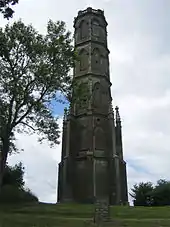
Charborough is an historic former parish and manor in Dorset, England. It survives today as a hamlet, situated on an affluent of the River Stour, 6 miles west of Wimborne Minster,[1] but without any of its former administrative powers, and is today part of the parish of Morden. The surviving former parish church is dedicated to Saint Mary.[2] The manor house survives as Charborough House.
St Mary's Church
The mediaeval church of the former parish of Charborough was situated to the immediate south-west of the manor house (in its latest form Charborough House). The mediaeval church was demolished and rebuilt on the same site (50°46′49″N 2°06′27″W / 50.78018°N 2.10752°W) in 1775 in the Gothic Revival style,[3] by Thomas Erle Drax, and dedicated to St Mary, and was remodelled in 1837 by John Sawbridge Erle-Drax who in 1826 had married the heiress Sarah Frances Erle-Drax of Charborough,[4] and had assumed her surname and arms. It faces almost due east, as is usual, whilst the front facade of the house faces north-east. It is a grade II* listed building, but the listing relates only to its furnishings.[5] Today it serves as a mausoleum and burial place for the Drax family, the functioning parish church being at Morden. Above the door of a small arched building nearby is an inscription, dated 1686, commemorating the meeting of the "Patriotic individuals who concerted the plan of the Revolution in 1688".
Charborough Tower

Charborough Tower is a Grade II* listed octagonal folly tower dating from 1790, extended in 1839 into a five-storey building. It is situated on a hill southeast of the house (50°46′39″N 2°06′06″W / 50.77753°N 2.10178°W),[6] with the vista of a triumphal way running between them.[7]
Charborough with its tower is the model for "Welland House" in the novel Two on a Tower by Thomas Hardy.[8]
Descent of the manor
The manor is listed in the Domesday Book of 1086.[9] It was later acquired during the reign of Queen Elizabeth I (1558-1603) by the Erle family whose eventual heiress Frances Erle married Sir Edward Ernle, 3rd Baronet (c.1673–1729). It descended by various further female lines to the present (notional)[10] lord of the manor Richard Drax,[11] the Conservative Member of Parliament for South Dorset since 2010, a member of the quadruple-barrelled surnamed family of Plunkett-Ernle-Erle-Drax. The Erle (alias Earl, Earle, etc.) family originated in east Devon and moved to neighbouring Dorset in about 1500, but soon died out in the male line. Female co-heiresses brought the Erle estates to various other families.
References
- ↑ Wilson, John M., Imperial Gazetteer of England and Wales, London, 1870
- ↑ "Parish Church of Saint Mary, Charborough, Morden, Dorset".
- ↑ Listed building text
- ↑ www.historyofparliamentonline.org
- ↑ Historic England. "Parish Church of Saint Mary, Charborough (1120553)". National Heritage List for England. Retrieved 6 July 2014.
- ↑ Historic England. "Charborough Tower (1120555)". National Heritage List for England. Retrieved 6 July 2014.
- ↑ Newman, John; Pevsner, Nikolaus (1997). The Buildings of England: Dorset. London: Penguin. pp. 139–141. ISBN 0-14-071044-2.
- ↑ "Letter from Hardy to Bertram Windle, transcribed by Birgit Plietzsch, from CL, vol 2, pp 131-133". Archived from the original on 2007-01-02. Retrieved 2016-12-25.
- ↑ Charborough House - Domesday Book
- ↑ Manors and manorial courts were largely abolished on the abolition of feudal tenure in the Tenures Abolition Act 1660
- ↑ Biography from Great British Life